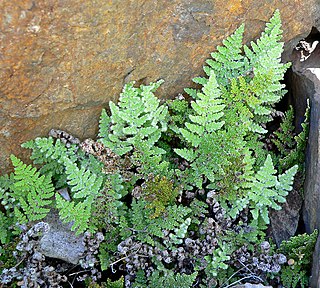
Myriopteris covillei, formerly known as Cheilanthes covillei, is a species of cheilanthoid fern known by the common name Coville's lip fern. Coville's lip fern is native to the southwestern United States and Mexico.
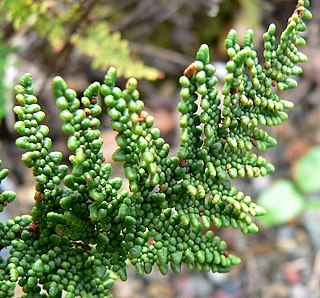
Myriopteris clevelandii, formerly known as Cheilanthes clevelandii, is a species of lip fern known by the common name Cleveland's lip fern. It is native to southern California and Baja California in Mexico. The leaf is divided into small, bead-like segments densely covered with scales beneath. In M. clevelandii, some of these scales are reduced to hairlike structures, which help distinguish it from the closely related M. covillei. It is usually found growing on exposed rock, particularly igneous rock.
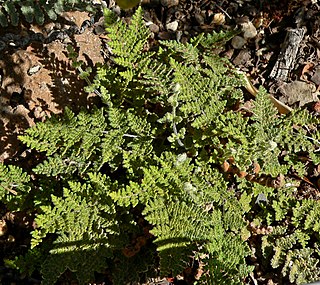
Myriopteris gracilis, formerly known as Cheilanthes feei, is a species of lip fern known by the common name slender lip fern or Fee's lip fern.
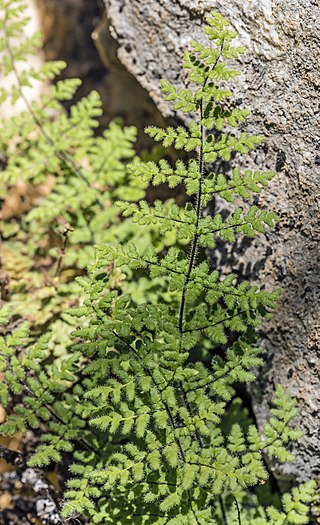
Myriopteris cooperae, formerly Cheilanthes cooperae, is a species of lip fern known by the common name Mrs. Cooper's lip fern, or simply Cooper's lip fern. Its leaves grow in clusters and are highly dissected into oblong segments, rather than the beadlike segments found in some other members of the genus. The axes of the leaves are dark and covered in long, flattened hairs. It is only known from California, where it grows in rocky habitats, usually over limestone. The species was named in honor of its collector, Sarah Paxson Cooper; according to Daniel Cady Eaton, who described it in 1875, it was the first fern species to be named for a female botanist.

Myriopteris intertexta, formerly Cheilanthes intertexta, is a species of lip fern known by the common name coastal lip fern. It is native to montane California and western Nevada, Oregon east of the Cascades, and with a disjunct population in central Utah. It grows in dry rocky habitats in sun, typically in rock cracks with little or no soil.
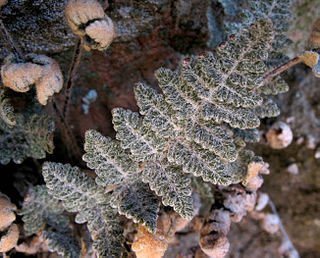
Myriopteris newberryi, formerly Cheilanthes newberryi, is a species of lip fern known by the common name Newberry's lip fern. It is native to southern California and Baja California.

Myriopteris tomentosa, formerly known as Cheilanthes tomentosa, is a perennial fern known as woolly lipfern. Woolly lipfern is native to the southern United States, from Virginia to Arizona and Georgia, and Mexico.
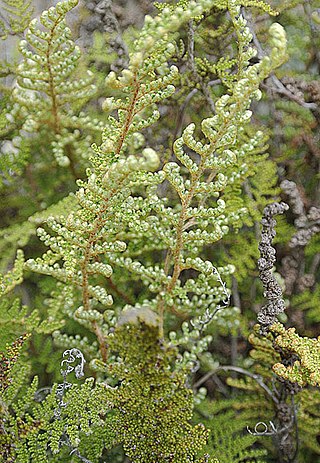
Myriopteris myriophylla, the Central American lace fern, is a species of lip fern. Despite its common name, this species is native as far south as Argentina. It is adapted to dry areas.

Myriopteris lanosa, the hairy lip fern, is a moderately-sized fern of the eastern United States, a member of the family Pteridaceae. Its leaves and stem are sparsely covered in hairs, but lack scales, hence its common name. One of the cheilanthoid ferns, it was usually classified in the genus Cheilanthes until 2013, when the genus Myriopteris was again recognized as separate from Cheilanthes. It typically grows in shallow, dry, soil, often in rocky habitats.

Myriopteris alabamensis, the Alabama lip fern, is a moderately-sized fern of the United States and Mexico, a member of the family Pteridaceae. Unlike many members of its genus, its leaves have a few hairs on upper and lower surfaces, or lack them entirely. One of the cheilanthoid ferns, it was usually classified in the genus Cheilanthes as Cheilanthes alabamensis until 2013, when the genus Myriopteris was again recognized as separate from Cheilanthes. It typically grows in shade on limestone outcrops.
Myriopteris aemula, the Texas lip fern or rival lip fern, is a moderately-sized fern of Texas and Mexico, a member of the family Pteridaceae. Unlike many members of its genus, its leaves have a few hairs on upper and lower surfaces, or lack them entirely. One of the cheilanthoid ferns, it was usually classified in the genus Cheilanthes as Cheilanthes aemula until 2013, when the genus Myriopteris was again recognized as separate from Cheilanthes. It typically grows on limestone rock.
Myriopteris yatskievychiana is a small fern native to Mexico, a member of the family Pteridaceae. It is known only from a single collection in the Mexican state of Sonora. While superficially similar to golden lip fern, a widespread species in Mexico, differences in its coating of hairs and its small size make it distinctive. One of the cheilanthoid ferns, it was usually classified in the genus Cheilanthes until 2013, when the genus Myriopteris was again recognized as separate from Cheilanthes.
Myriopteris allosuroides is a moderately-sized fern of Mexico, a member of the family Pteridaceae. Unlike many members of its genus, its rachides are grooved on the upper surface and largely free of hairs or scales. One of the cheilanthoid ferns, it was usually classified in the genera Cheilanthes or Pellaea until 2013, when the genus Myriopteris was again recognized as separate from Cheilanthes. It typically grows on dry, rocky slopes over acidic, particularly basaltic, rock.

Myriopteris aurea, the golden lip fern or Bonaire lip fern, is a moderately-sized fern native to the Americas, a member of the family Pteridaceae. Unlike many members of its genus, its leaf is only modestly dissected into lobed leaflets (pinnae), which are hairy both above and below. One of the cheilanthoid ferns, until 2013 it was classified in the genus Cheilanthes as Cheilanthes bonariensis, when the genus Myriopteris was again recognized as separate from Cheilanthes. It typically grows on dry, rocky slopes, and ranges from Mexico, where it is common and widespread, and the southwestern United States south and east through Central and South America as far as Chile and Argentina.
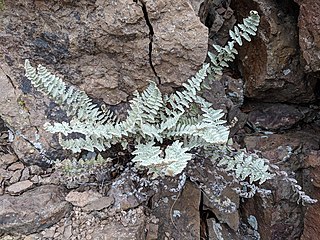
Myriopteris rufa, commonly known as Eaton's lip fern, is a moderately-sized fern of Mexico and the southwestern United States, with outlying populations in Costa Rica and the Appalachian Mountains. One of the cheilanthoid ferns, it was usually classified in the genus Cheilanthes, as Cheilanthes eatonii, until 2013, when the genus Myriopteris was again recognized as separate from Cheilanthes. It typically grows in rocky habitats, most frequently on limestone but also sometimes on basalt or shale.
Myriopteris longipila, formerly known as Cheilanthes longipila, is a species of fern native to Mexico. It is characterized by a dense covering of long whitish hairs.

Myriopteris rawsonii, formerly known as Cheilanthes rawsonii, is a perennial fern native to Namaqualand in Southern Africa. Like many other cheilanthoid ferns, it is adapted to dry conditions, bearing a thick layer of pale hairs on the underside of its pinnate-pinnatifid leaves. It is the only African representative of its clade of cheilanthoids, the otherwise American genus Myriopteris. It spends much of the year in a dried-out, dormant state, rehydrating and putting out new growth during winter rains. Its name honors the botanist and civil servant Sir Rawson W. Rawson.

Myriopteris yavapensis, formerly known as Cheilanthes yavapensis, is a species of cheilanthoid fern with the common name Yavapai lip fern native to the southwest United States.
Myriopteris chipinquensis is a fern endemic to Mexico, a member of the family Pteridaceae. One of the cheilanthoid ferns, it was classified in the genus Cheilanthes until 2013, when the genus Myriopteris was again recognized as separate from Cheilanthes. It grows in oak-pine forests of the Sierra Madre Oriental, often with the very similar and closely related Myriopteris tomentosa.
Myriopteris cinnamomea is a Central American fern. It is very similar to M. mickelii of southern Mexico and to other species in the "alabamensis clade" of Myriopteris. It is modestly sized, with leaves not more than 30 centimeters (12 in) long. They are divided into pinnae, which in turn are divided into lobed pinnules, and covered with pale brown hairs on the underside.

















